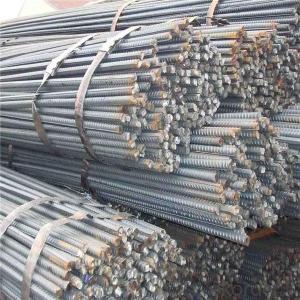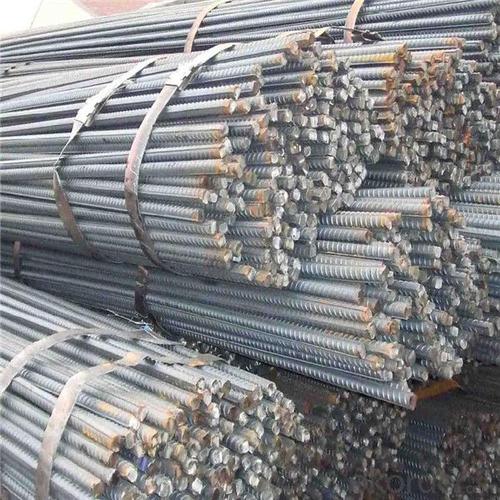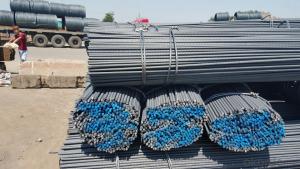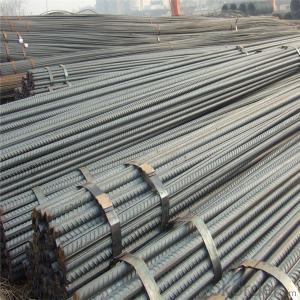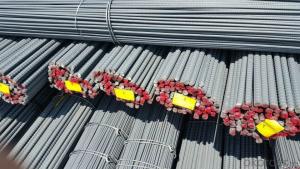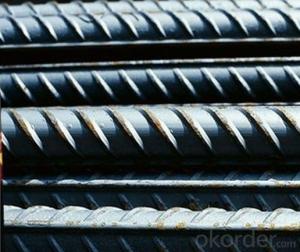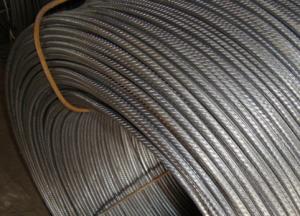Trade Assurance steel rebar from good mill
- Loading Port:
- Tianjin
- Payment Terms:
- TT OR LC
- Min Order Qty:
- 100 m.t.
- Supply Capability:
- 18000 m.t./month
OKorder Service Pledge
OKorder Financial Service
You Might Also Like
Specification
Rebar (short for reinforcing bar), also known as reinforcing steel, reinforcement steel, is a steel bar
or mesh of steel wires used as a tension device in reinforced concrete and reinforced masonry structures
to strengthen and hold the concrete in tension. Rebar's surface is often patterned to form a better bond with
the concrete.
Our Advantage: High quality steel products from 1 class mills in China
Reasonable price
Professionalism of the products
On-time delivery
Complete documents and certificates
Sincere service to meet our clients' requirements
Product Description :
Chemical composition (%): | Steel | C | Si | Mn | P | S | Ceq | ||||
HRB335 |
0.25 |
0.80 |
1.60 |
0.045 |
0.045 | 0.52 | |||||
HRB400 | 0.54 | ||||||||||
HRB500 | 0.55 | ||||||||||
Mechanical properties | Steel | Rel/ MPa | Rm/ MPa | A/ % | Agt/ % | ||||||
≥ | |||||||||||
HRB335 | 335 | 455 | 17 |
7.5 | |||||||
HRB400 | 400 | 540 | 16 | ||||||||
HRB500 | 500 | 630 | 15 | ||||||||
Package: | Standard export packing or as customer's request | ||||||||||
Application: | Construction, building, bridge, road. ect | ||||||||||
Payment terms | 1).100% irrevocable L/C at sight. | ||||||||||
Delivery time | 15-30 days after receipt of L/C or deposit by T/T | ||||||||||
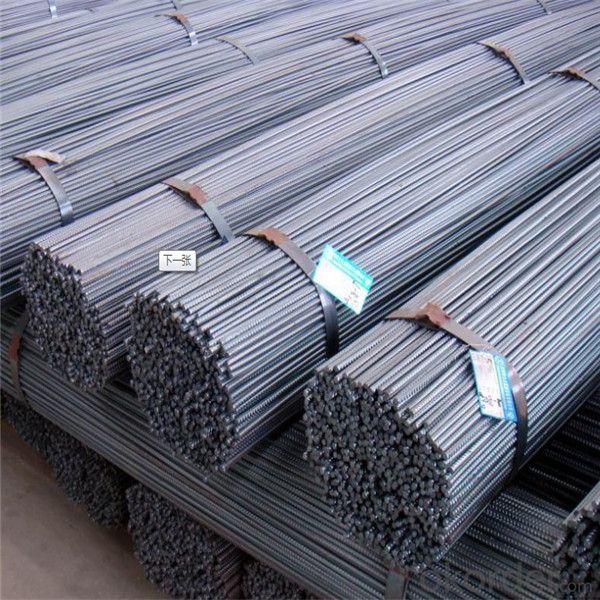
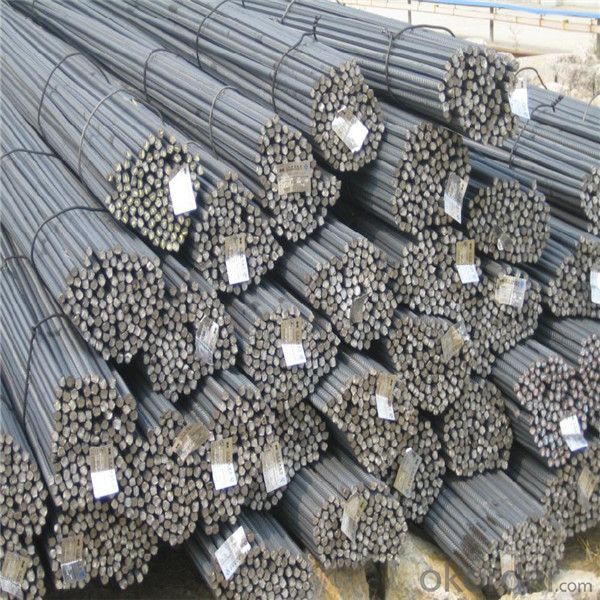
Packing:
In bundles, each bundle weight 3.5 tons. Load by container or by bulk verssel.
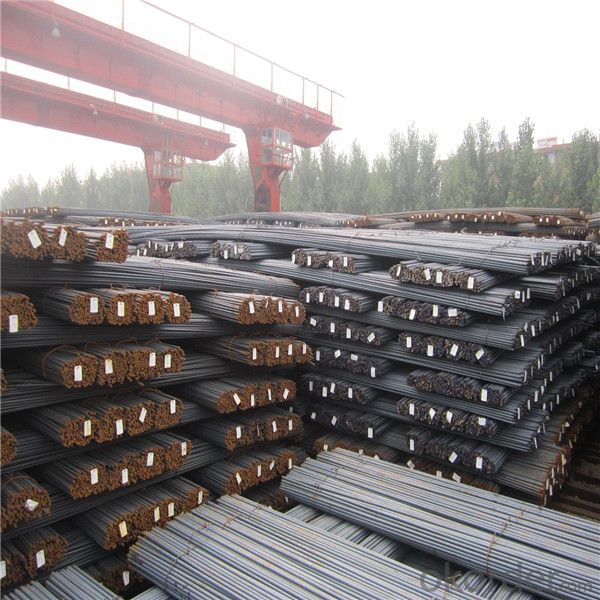

Our service
(1) We cooperate with famous factories with advanced equipment and well trained workers.
(2) We can provide factory price with trading company service.
(3) We continuously work on the improvement of our processes, guaranteeing consistently high standards
of quality to keep none compensation.
(4) We guarantee 24 hours response and 48 hours solution providing service.
(5) We accept small order quantity before formal cooperation.
(6) We deliver the agreed quality at the agreed time, reacting to changes in customer wishes in a flexible way.
(7) Due to our volume and selling power, we have excellent freight rates with shipping lines.
(8) We strive to always be fair and honest in our dealings with customers.
(9) We strive to work together with customers to achieve much more than we can achieve alone.
(10) Through our passion and commitment we aim to be a market leader in all our key markets. To maintain
our position as market leader we must continue to add value in all that we do.
FAQ:
1.Q: What's your MOQ(minimum order quantity)?
A: One full container, mixed acceptable .
2. Q: What's your packing methods?
A: Packed in bundle or bulk ..
3. Q: How can I buy CNBM products in my country?
A:Please send us an inquiry or email ,we will reply to you if there is distributor in your country
4. Q: Can we visit your factory?
A: Warmly welcome. Once we have your schedule, we will arrange the professional sales team to follow up your case.
5. Q: How long does it take to get the product if i place an order?
A:With the process of your requirements,we will pack and deliver in 3-7 days. If it is by sea shipment,it will take 15-45 days depending on different locations
- Q: What are the weight and density of steel rebars?
- Steel rebars, also known as reinforcing bars, are commonly utilized in construction to impart tensile strength to concrete structures. The weight and density of steel rebars may differ depending on their size and grade. The weight of a steel rebar is determined by its cross-sectional area and the specific weight of steel, which is roughly 7850 kilograms per cubic meter (or 0.2836 pounds per cubic inch). The cross-sectional area is usually quantified in square millimeters or square inches. For instance, a prevalent size of steel rebar is the #4 bar, possessing a diameter of 12.7 millimeters (or 0.5 inches) and a cross-sectional area of 127 square millimeters (or 0.197 square inches). By employing the specific weight of steel, we can compute the weight of a #4 rebar in the following way: Weight = Cross-sectional area x Specific weight of steel Weight = 127 mm^2 x 7850 kg/m^3 Weight = 998,950 grams or approximately 998.95 kilograms (or 2,201 pounds) Concerning density, the density of steel rebars coincides with the specific weight of steel, which is roughly 7850 kilograms per cubic meter. This density remains relatively consistent across diverse sizes and grades of steel rebars. It is important to acknowledge that the weight and density of steel rebars may slightly fluctuate based on the precise composition and manufacturing process. It is therefore prudent to refer to the manufacturer's specifications or consult engineering references for precise and up-to-date information.
- Q: What is the effect of welding defects on the performance of steel rebars?
- Welding defects can have a significant impact on the performance of steel rebars. These defects can weaken the structural integrity of the rebars, leading to potential failures and compromising the overall strength and durability of the construction project. One of the common welding defects is porosity, which is caused by the presence of gas pockets or voids in the weld. Porosity weakens the weld joint, reducing its load-bearing capacity and making it more susceptible to cracking or breaking under stress. This can result in a decreased resistance to external forces, such as the weight of the structure or seismic activities, leading to potential collapse or structural failure. Another welding defect is lack of fusion, which occurs when there is insufficient bonding between the base metal and the weld metal. This results in a weak joint that is prone to separation or cracking under load. Lack of fusion can lead to reduced mechanical strength and compromised structural performance, as the rebars may not be able to withstand the expected load or forces exerted on them. Furthermore, the presence of weld spatter or excessive weld reinforcement can also negatively affect the performance of steel rebars. Weld spatter refers to the undesirable splashes or droplets of molten metal that can adhere to the surface of the rebar, creating potential weak points. Excessive weld reinforcement, on the other hand, can add unnecessary weight to the rebar and create stress concentrations, further increasing the likelihood of failure. In summary, welding defects on steel rebars can significantly impact their performance by weakening the structural integrity, reducing load-bearing capacity, and increasing the susceptibility to cracking or breaking under stress. Therefore, it is crucial to ensure proper welding techniques and quality control measures are in place to minimize or eliminate these defects and ensure the safety and reliability of the construction project.
- Q: How are steel rebars inspected for quality on construction sites?
- Steel rebars are critical components in construction projects, as they provide reinforcement and strength to concrete structures. Ensuring the quality of steel rebars is crucial to guarantee the safety and durability of the overall construction. To inspect the quality of steel rebars on construction sites, several methods are commonly employed. Visual Inspection: The first and most basic method of quality inspection involves visual examination of the rebars. This includes checking for any visible defects such as cracks, deformations, rust, or surface irregularities. Any rebars with such flaws are immediately identified and rejected. Measurement and Dimensional Checks: Steel rebars need to meet specific dimensional requirements as per project specifications and industry standards. Inspection personnel use measuring tools, such as calipers or tape measures, to verify the length, diameter, and other dimensions of the rebars. Any deviation from the specified tolerances may lead to rejection. Magnetic Particle Testing (MPT): MPT is a non-destructive testing method commonly used to detect surface and near-surface defects in steel rebars. This technique involves magnetizing the rebar and applying ferromagnetic particles, which accumulate at any surface defects or cracks. By carefully inspecting the surface, trained inspectors can identify any areas of concern. Ultrasonic Testing (UT): UT is another non-destructive testing method used for inspecting rebars. It involves the use of ultrasonic waves that are transmitted through the rebar. These waves reflect back differently when encountering any defects, such as voids, cracks, or inclusions. By analyzing the reflected waves, trained technicians can identify and assess the quality of the rebars. Tensile Testing: Tensile strength is a crucial factor in determining the quality of steel rebars. Tensile testing involves pulling a sample rebar until it breaks, measuring the force required to do so. This test helps determine the strength and ductility of the rebar, ensuring it meets the required standards. Chemical Analysis: Steel rebars are often subjected to chemical analysis to ensure they meet the specified composition requirements. Samples are collected from the rebars, and various tests are conducted to determine the chemical composition, including carbon, manganese, and other alloying elements. This analysis helps ensure the rebars possess the necessary properties for the intended application. All these inspection methods are typically conducted by qualified and experienced personnel, such as certified welding inspectors or quality control technicians. By employing these quality inspection procedures, construction sites can ensure that the steel rebars used in their projects meet the required standards, thereby ensuring the safety and longevity of the structures being built.
- Q: How do steel rebars provide flexibility to concrete structures?
- Steel rebars provide flexibility to concrete structures in several ways. Firstly, steel rebars are used to reinforce concrete, which helps to increase the tensile strength of the structure. Concrete is strong in compression but weak in tension. By adding steel rebars, the concrete becomes more resistant to bending and cracking, as the rebars can absorb the tensile forces that would otherwise cause the concrete to fail. This reinforcement allows concrete structures to withstand greater loads and provides flexibility by preventing excessive deformation or collapse. Secondly, steel rebars can be used to create a reinforced concrete frame, which enhances the overall flexibility of the structure. The rebars, when embedded in the concrete, form a network of interconnected elements that distribute the applied loads more evenly. This network acts as a flexible skeleton that can adapt to different stresses, such as changes in temperature, ground movements, or dynamic forces. Consequently, the structure can accommodate slight movements or vibrations without suffering significant damage. Moreover, steel rebars can be strategically placed in areas where additional flexibility is required. For example, in seismic-prone regions, rebars can be concentrated in critical areas such as the joints or corners of a building. This placement helps to dissipate the energy generated during an earthquake, allowing the structure to deform and absorb the seismic forces without collapsing. This flexibility provided by the steel rebars helps to enhance the seismic resistance of the concrete structure. In summary, steel rebars provide flexibility to concrete structures by increasing their tensile strength, creating a reinforced concrete frame, and allowing for strategic placement to enhance specific areas of flexibility. This flexibility helps concrete structures withstand various loads, adapt to different stresses, and improve their overall strength and durability.
- Q: What is the role of steel rebars in minimizing the risk of concrete spalling due to sulfate attack?
- Steel rebars play a crucial role in minimizing the risk of concrete spalling due to sulfate attack by providing reinforcement and increasing the overall strength of the concrete structure. When concrete is exposed to sulfate ions, it can undergo a chemical reaction that leads to expansion and cracking, resulting in spalling. However, steel rebars act as a reinforcement, helping to distribute the stress and load throughout the concrete, reducing the risk of cracking and spalling. Additionally, the presence of rebars helps to maintain the structural integrity of the concrete, preventing the ingress of sulfate ions and minimizing the potential for sulfate attack.
- Q: Can steel rebars be used in structures with high alkaline environments?
- Yes, steel rebars can be used in structures with high alkaline environments. Steel rebars are commonly used in concrete structures and are designed to withstand various environmental conditions, including high alkaline environments. However, it is essential to ensure that the appropriate type of steel rebar is selected to prevent corrosion and maintain structural integrity in such conditions.
- Q: What is the recommended method for splicing steel rebars together?
- The recommended method for splicing steel rebars together is typically done using mechanical splices or couplers, which provide a strong and reliable connection between the rebars. This method involves joining the rebars by screwing, clamping, or compressing them together, ensuring sufficient overlap and adequate transfer of load between the bars. It is important to follow the specific guidelines and recommendations provided by structural engineers, as well as any applicable building codes and standards, to ensure the integrity and safety of the spliced rebars.
- Q: What are the factors to consider while choosing the right type of steel rebar for a project?
- When choosing the right type of steel rebar for a project, several factors need to be considered. These factors include the grade and quality of the steel, the required strength and durability, the environmental conditions of the project site, the structural design and specifications, the budget, and any specific regulations or standards that need to be followed. Additionally, factors such as corrosion resistance, weldability, and availability of the steel rebar should also be taken into account. Overall, a comprehensive analysis of these factors will help in selecting the most suitable steel rebar for the project.
- Q: What are the common sizes of steel rebars used in construction?
- The sizes of steel rebars used in construction can vary depending on the specific application and engineering requirements. However, there are several standard sizes that are widely used in the industry. The industry commonly utilizes rebar sizes ranging from #3 to #18. These numbers represent the diameter of the rebar in eighths of an inch. For instance, a #3 rebar has a diameter of 3/8 inch, while a #18 rebar has a diameter of 2 1/4 inches. Regarding metric measurements, the most frequently used rebar sizes range from 10mm to 40mm in diameter. These sizes are typically designated by their nominal diameter in millimeters, such as 10mm, 12mm, 16mm, 20mm, 25mm, 32mm, and 40mm. The selection of the appropriate rebar size depends on various factors, including the required load-bearing capacity, the structural design, and the type of construction project. Smaller diameter rebars, like #3 or 10mm, are typically utilized in lighter construction projects or for smaller concrete elements like walls or slabs. Conversely, larger diameter rebars, like #18 or 40mm, are commonly employed in heavy-duty applications such as bridges, high-rise buildings, or large-scale infrastructure projects. It is important to note that different countries or regions may have their own specific standards regarding rebar sizes. Consequently, it is crucial to consult local building codes and regulations to ensure compliance.
- Q: Do steel rebars increase the overall weight of a structure?
- Yes, steel rebars do increase the overall weight of a structure. Rebars are typically used to reinforce concrete, providing additional strength and stability. Since steel is denser than concrete, the addition of rebars adds weight to the structure.
Send your message to us
Trade Assurance steel rebar from good mill
- Loading Port:
- Tianjin
- Payment Terms:
- TT OR LC
- Min Order Qty:
- 100 m.t.
- Supply Capability:
- 18000 m.t./month
OKorder Service Pledge
OKorder Financial Service
Similar products
Hot products
Hot Searches
Related keywords
